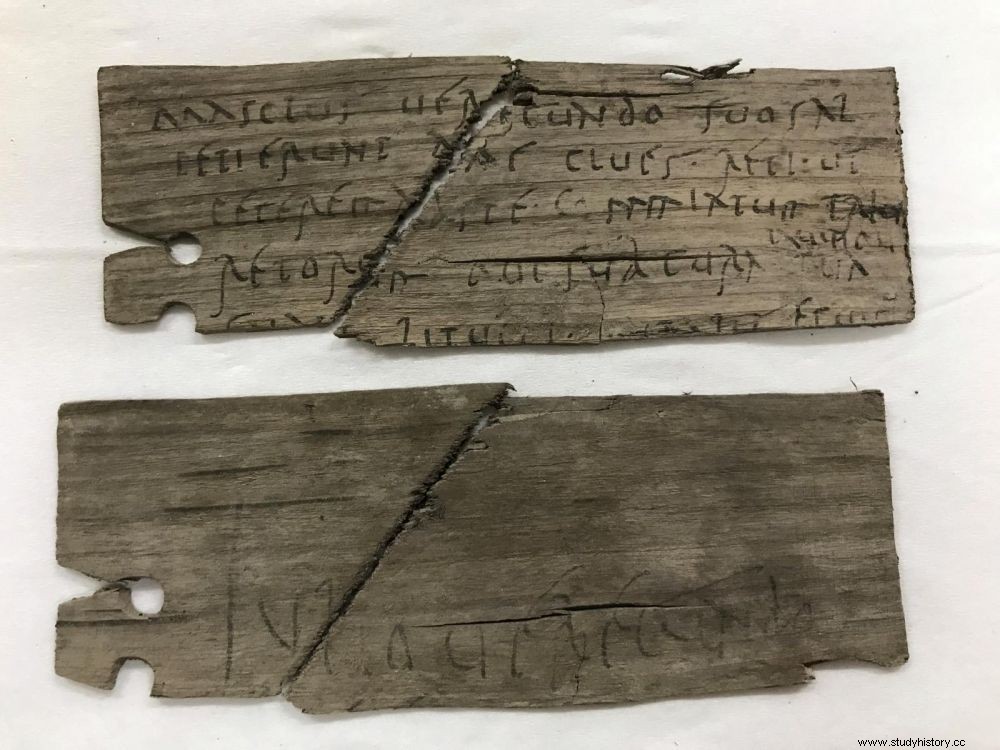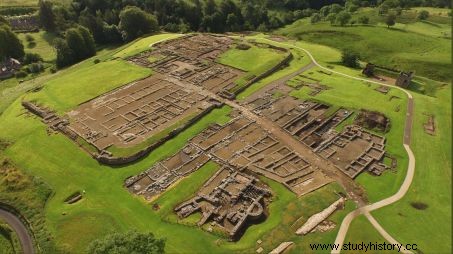Unearthed in 2017 in the north of England, new tablets detailing the lives of Roman soldiers at the limes of the empire have just been translated and published.

Letter from Masclus to Julius Verecundus, from Vindolanda.
It is a new batch of four wooden plaques covered with writings traced in ink, found in the muddy soils of an ancient Roman fortress in present-day Northumberland, not far from the border of Scotland, that comes to disclose the magazine Britannia. Cheering 2000 year old documents in the name of Julius Verecundus, then prefect of the citadel of Vindolanda (1st-5th century), one of the many defensive structures located along the 117 kilometers of the wall built around 120 CE at the request of Emperor Hadrian (76-138). In 2017, Sciences et Avenir had already revealed the conditions under which British archaeologists had made the finds of 24 of these wooden plaques and calligraphic fragments that scholars call Tabulae vindolandenses, and whose meticulous deciphering, 19 centuries later, has just been completed.
"Correspondence to and from Julius Verecundus that gives us unparalleled insight into the daily life of a senior officer stationed in the far north of the Roman Empire “, explains Andrew Berley, the director general of the Vindolanda Trust, joined by Sciences et Avenir.

Aerial view of the Roman fortress of Vindolanda, on the border of Scotland and England. © Vindolanda Trust
No sensational announcements at first glance, but moving information imprinted with human proximity.
Commander of the First Cohort of Tongrians (or Tongres), an ancient people of Belgian Gaul, Julius Verecundus, at the head of a military cavalry unit, thus addresses in a first note to his slave Audax, whom he greet him before asking him about a problem transporting a load of fresh vegetables as well as a story of a key sent by mistake, the one received being assigned "to the small reserve"...
Another missive, this time from a certain Andangius (Germanic name attested in the Rhineland), still addressed to the prefect Julius Verecundus, solicits a favor from a man named Crispus the measurer ( the surveyor? the scheduler?), in order to "lighten his service". Remember that in the Roman Empire, the duration of military service was… 25 years! Perhaps a request for a friend - as it is presented - to be excused from being overworked?
Beer and cuttings!
It is a new batch of four wooden plaques covered with writings traced in ink, found in the muddy soils of an ancient Roman fortress in present-day Northumberland, not far from the border of Scotland, that comes to disclose the magazine Britannia. Pleasant 2,000-year-old documents in the name of Julius Verecundus, then prefect of the citadel of Vindolanda (1 st -5 e century), one of the many defensive structures located along the 117 kilometers of the wall built around 120 CE at the request of Emperor Hadrian (76-138). In 2017, Sciences et Avenir had already revealed the conditions under which British archaeologists had made the finds of 24 of these wooden plaques and calligraphic fragments that scholars call Tabulae vindolandenses, and whose meticulous deciphering, 19 centuries later, has just been completed.
"Correspondence to and from Julius Verecundus that gives us unparalleled insight into the daily life of a senior officer stationed in the far north of the Roman Empire “, explains Andrew Berley, the director general of the Vindolanda Trust, joined by Sciences et Avenir.

Aerial view of the Roman fortress of Vindolanda, on the border of Scotland and England. © Vindolanda Trust
No sensational announcements at first glance, but moving information imprinted with human proximity.
Commander of the First Cohort of Tongrians (or Tongres), an ancient people of Belgian Gaul, Julius Verecundus, at the head of a military cavalry unit, thus addresses in a first note to his slave Audax, whom he greet him before asking him about a problem transporting a load of fresh vegetables as well as a story of a key sent by mistake, the one received being assigned "to the small reserve"...
Another missive, this time from a certain Andangius (Germanic name attested in the Rhineland), still addressed to the prefect Julius Verecundus, solicits a favor from a man named Crispus the measurer ( the surveyor? the scheduler?), in order to "lighten his service". Remember that in the Roman Empire, the duration of military service was… 25 years! Perhaps a request for a friend - as it is presented - to be excused from being overworked?
Beer and cuttings!
A third letter refers to Masclus, Decurion of his state, whose epistolary exchanges had already been reported in the tablets previously mentioned by Sciences et Avenir. Mainly because he wanted more beer sent to his men at the outposts of the wall! "We don't know of Masclus' ties to Julius Verecundus, but he was obviously stationed nearby (from Vindolanda, editor's note)and was at the head of a detachment (vexillation) of cavalry ", write the researchers. In this letter, Masclus, thus seems to recommend to Julius Verecundus a leave for "five men", who would be neither Tongrians, nor Batavians, but two Rétiens (Switzerland) and three Vocontiens (people of the south of Gaul). He adds a request for the recovery of a knife held by a certain Talempus, and indicates the sending of… cuttings of plants! Enough to imagine our Roman legionnaires gardening in the northern regions of Gaul. Verte Albion, there is only one step!
The fourth tablet, which has been made difficult to read due to multiple words that have become illegible, appears to be a complaint that Caecilius Secundus brings to the attention of Julius Verecundus, commander of the fort. It's about "little outbursts of anger" of a man named Decuminus, whose offenses will forever be ignored, but whose rapid settlement of the problem he poses is strongly required! These messages corroborate above all in their own way the multicultural composition of the Roman armies on the limes north of the empire at the 1 st century of our era, and perhaps also the tensions between men from different peoples that had to be resolved from time to time to maintain peace in the ranks!
How were the Roman armies made up
A legion comprised 5,000/6,000 men in time of offensive war, and 4,000 in time of peace. It was divided into ten cohorts, consisting of three maniples and six centuries each. They also had 132 horsemen who obeyed centurions, a number increased to 726 at the time of Gallienus (259-268). The exact number of legions is not known. 23 to 25, for example, would have existed at the death of Augustus (14 AD) (i.e. 150,000 men, without auxiliary units). Indeed, each legion – designated by a number and a nickname, like the Legio III Augusta – was accompanied by auxiliary units. The men who composed it were chosen from among different peoples:Gauls and Spaniards were renowned as horsemen, Bretons (Britannia) as scouts, Thracians and Syrians for their archery skills... and "the Germans for frighten enemies with their cruelty" . These auxiliary units were organized into cohorts equitatae and number, each grouping 500 men (fifties) or 1,000 (military, miles , soldier) under the authority of prefects. This is the case of the fortress of Vindolanda, and its miliary entrusted to Julius Verecundus. Under the empire (27 BC – 467 AD), the army of the borders consisted of more than 250,000 men in total.
Source:Yann le Bohec, professor emeritus at the Sorbonne (Paris), specialist in Roman warfare.
Find out more: "The Roman War", Yann le Bohec, Taillandier, 2014.
